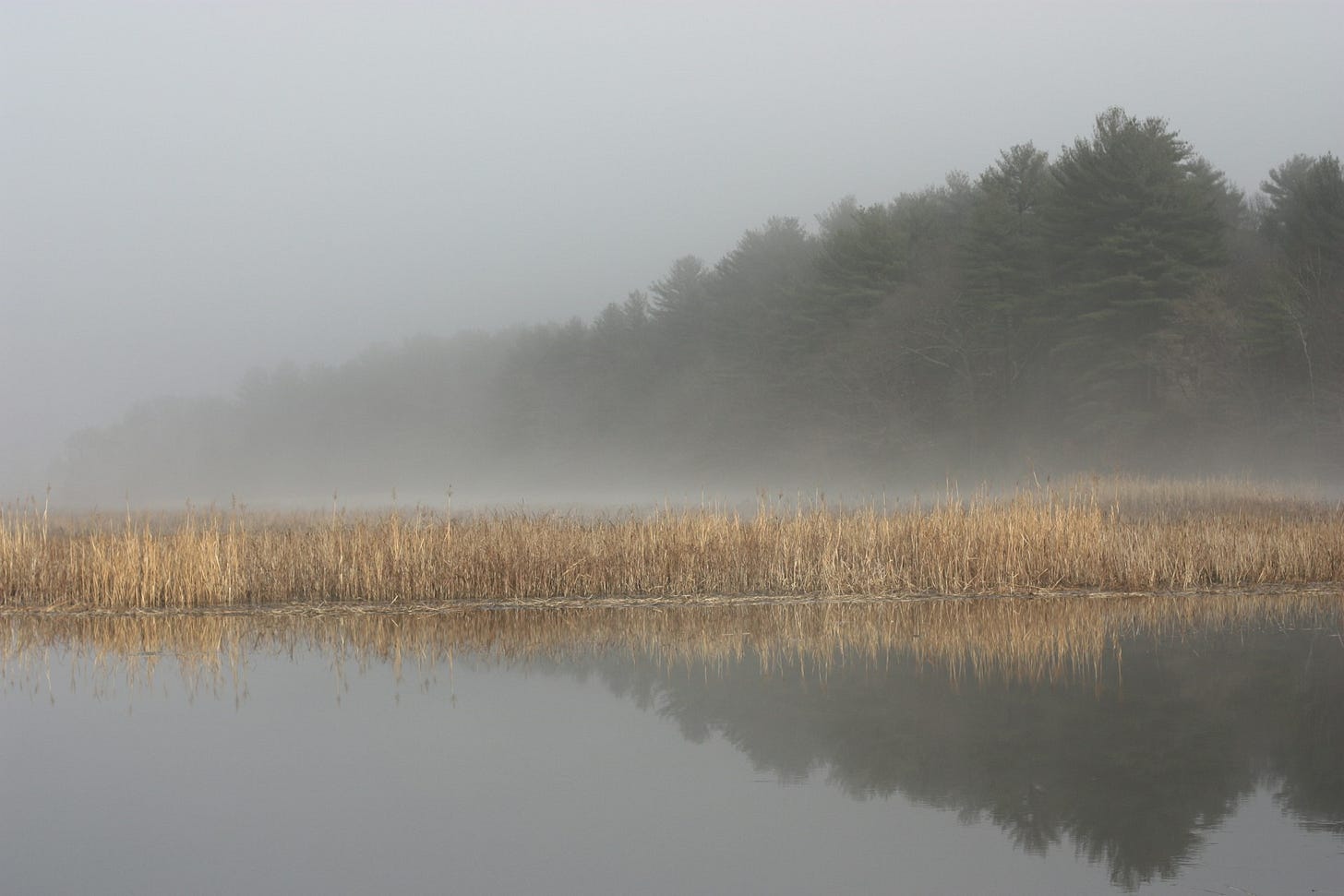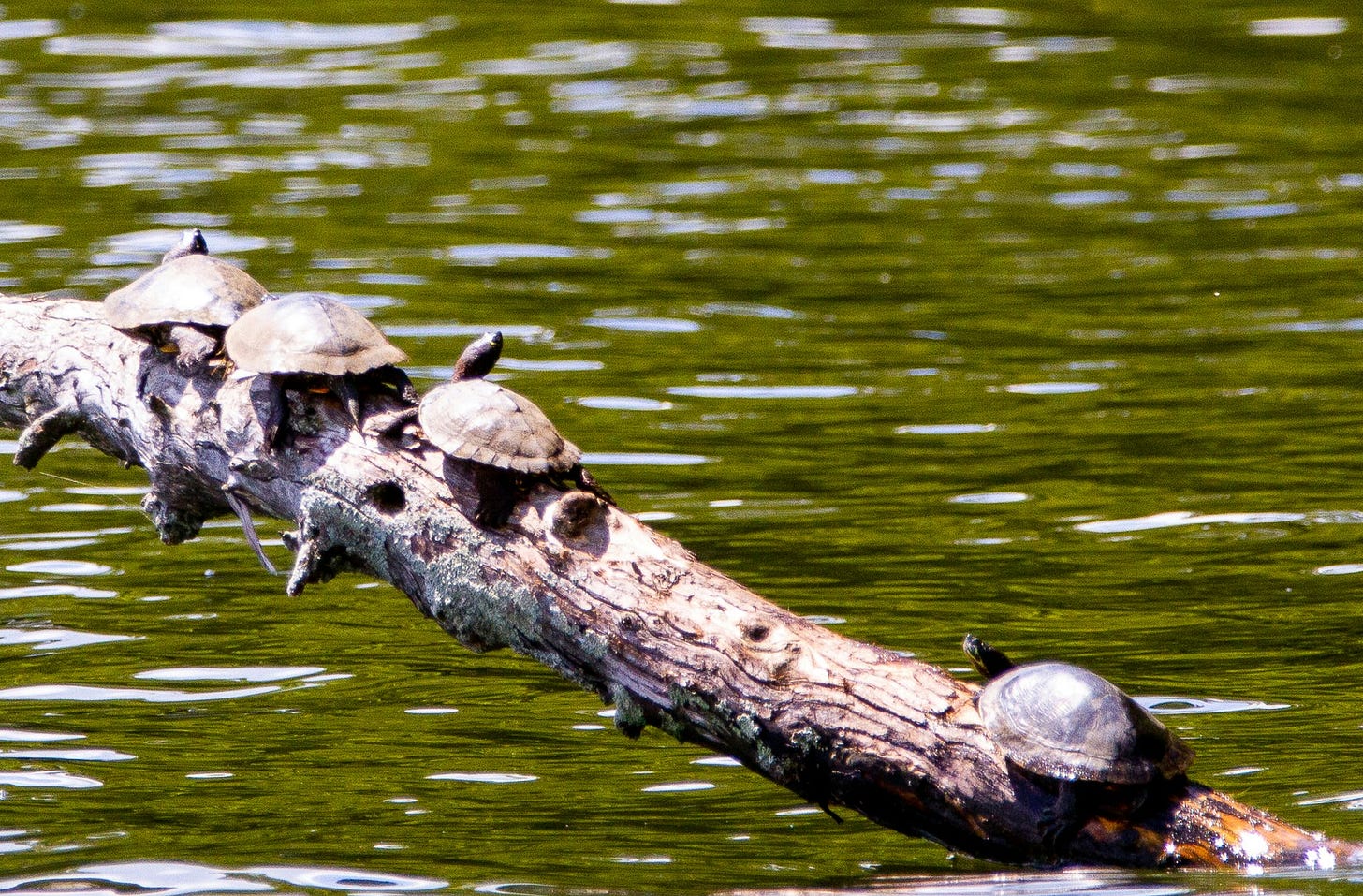The Marsh on a Misty Morning
A story about a magical early-morning walk. For children ages 4-8.
The world outside is dark and quiet. In the dim hall, Oakley and Dad put on their jackets. “What’s the marsh like this early?” Oakley asks.
“It’s magic,” says Dad. “You’ll see.”
The earth turns toward sunrise. Up on the hill, shapes begin to form in the darkness. But down in the marsh, everything is wrapped in a silvery quilt. Only the drip, drip of falling dew breaks the silence. The scents of damp and growing things fill the still air.
The world waits.
Suddenly the strident cry of a wood duck cuts the air. Startled, Oakley grabs Dad’s hand.
Hidden by the mist, a red-winged blackbird calls. From across the marsh comes an answering call.
A passing breeze carries the soft sounds of a mourning dove.
Deep within the reeds, marsh wrens start to rustle, then chitter and chatter. Oakley watches the reeds move, but the wrens are hiding.
A crow cries, “Come! Come! Wake up!”
Through the silvery gray, a tiny golden bird flits by like a drop of sunshine. “Goldfinch,” whispers Dad.
The sun rises, hidden behind the mist. It slowly turns the mist to gold.
Wafted by a breeze and heated by the sun, the mist starts to break apart.
“Look, Dad,” whispers Oakley. “The mist is melting, like cotton candy melts on my tongue.”
Along the shore, a green heron stretches its rusty brown neck and dips its head into the water, searching for breakfast. A muskrat swims away from its home, only its head and back above the water. Suddenly a silvery swirl cuts through the water. “A water snake,” says Dad. “They’re harmless.”
Mallards and ring-necked ducks swim out from the reeds, ready for breakfast. Canada geese leave their sleeping spots on the water. They swim toward the reeds, then waddle to shore for their meal.
High above, an osprey circles, then swoops into the pond. Rising with a wriggling fish, it flies to its nest. Dad touches Oakley’s arm. “Do you hear the osprey’s hungry hatchlings?”
A great blue heron, wet from a dip, shakes its head in the sun. Its long neck-feathers swirl like a dancer’s scarf, then lie flat again.
Sunlight sparkles on the water. Only strands of mist remain.
Turtles climb from the water. Oakley watches them march along a log, then settle to bask in the sun.
Blackbirds perch on cattails like sentinels, their calls as bright as their scarlet shoulders.
Dragonflies zip through colorful blossoms, then stop to hover in the sun. Their wings glint like gems. “Magic!” breathes Oakley. Dad nods.
The mist is gone, chased by the golden sun. Oakley’s tummy rumbles. “Time to go home?”
“Yes,” says Dad.
Another day begins.
For Parents, Teachers, and Others
This story grew from several dawn trips I took to Great Meadows National Wildlife Refuge in Concord, Massaachusetts. A very helpful ranger, whose name has gotten lost in the mists of time, gave me permission to be there before they officially opened for the day, as long as I stayed in my car until she came. Those days were long before cell phones, and I didn’t have a camera, so all the images are in my mind.
Those mornings were, truly , magical. I remember standing still, watching a coot’s morning routine. The path where I stood was so close I could have touched him, but he seemed oblivious to me.
Around 6 AM the joggers started appearing. One or two ran right past me, but one stopped to ask if I was okay; he was concerned because I hadn’t moved in all the time he’d been at the marsh. Finger to my lips in the universal sign for silence, I pointed out the coot. He shook his head as though I were crazy, and jogged off. I thought, What a shame to miss the magic of this place.
Noticing
There’s a big difference between seeing and looking carefully. Professional photographers know how to draw the viewer’s eye to a certain part of the picture so the details s/he finds interesting draw your attention. Very small children are good at focusing on very small details; think of the toddler who is fascinated by a bug crawling up a stem. But somehow this skill is lost very early. For school-age kids, finding interesting little bits of a scene takes practice.
I had a roommate once who told me that she would never forget the day in third grade when the art teacher brought a box of autumn leaves to class and gave each child a handful. The assignment was to copy two or three of them. My roommate said that at first she thought this was a stupid assignment; leaves were leaves. But as she followed instructions, she began to notice their differences. The shapes, the kind of edge (serrated or smooth), the colors, the sizes—all were different. “When I went outside after school that day,” my roommate recalled, “it was as though the world had suddenly gone from black-and-white to color. I never saw the world the same again.”
When a parent points out flowers and says, “There’s a flower,” or “See the flower?” the child will learn to see flowers, but may not be able to distinguish between them. When the parent says, “See the daffodil,” “See the violet,” the child learns that there are many different kinds of flowers. No one has to explain the differences; the child figures that out for himself.
I use an app to identify birds here in my new home in Israel. I can capture the bird’s song on the app and the app makes a tentative identification, showing me a picture and a few words about the bird’s habitat and habits. These days, there are identification apps for plants and insects as well. Using these when out with children would be a great way to help them learn to see details. Letting kids photograph, either with their own camera or with a phone’s, can also be a good way to help kids learn to see details.
Of course, there’s also the child who always sees the details and misses the big picture. Helping them photograph landscapes instead of small details would be helpful to broaden their visual horizons.
I would love to hear if you put any of these ideas into practice; you can always return to this post and add comments.






Thanks!
Your descriptions are magical and beautiful.